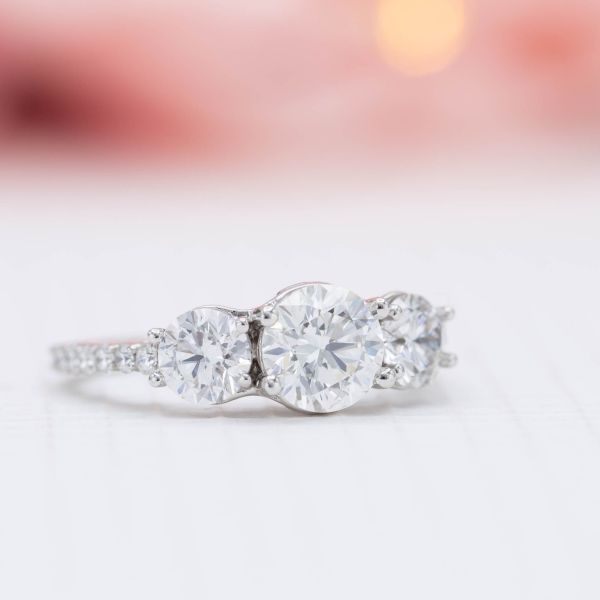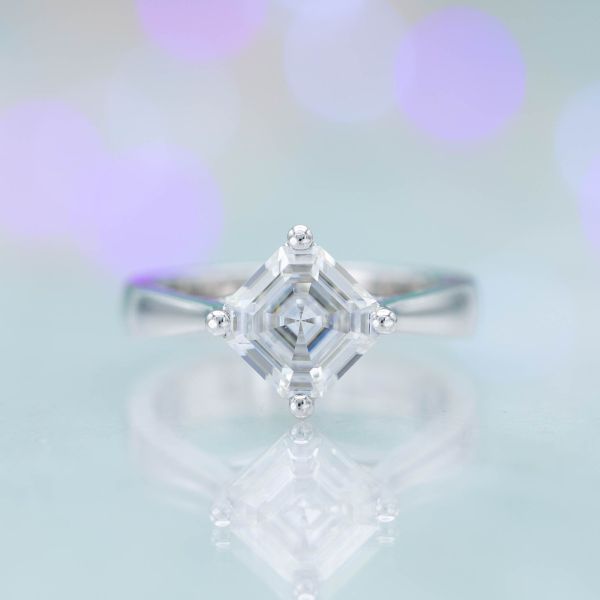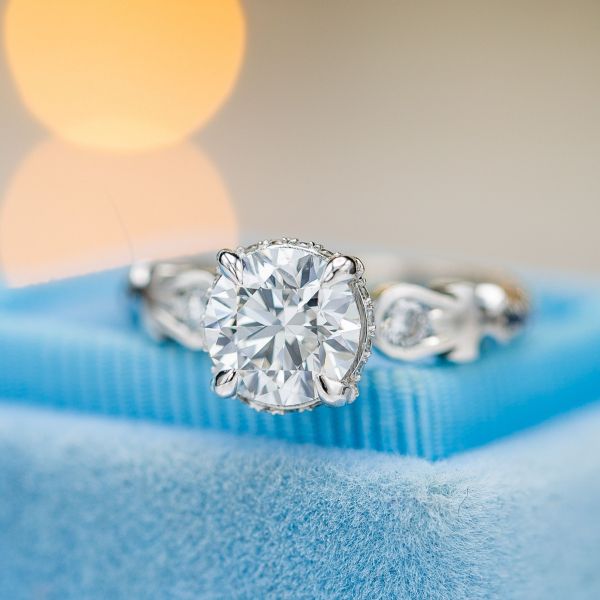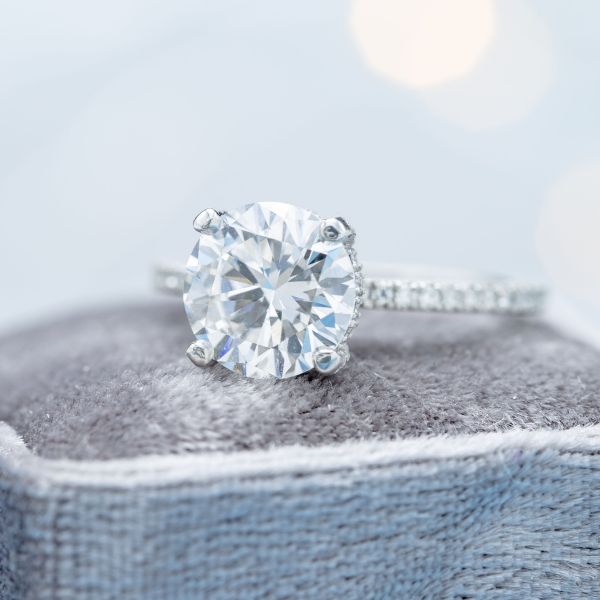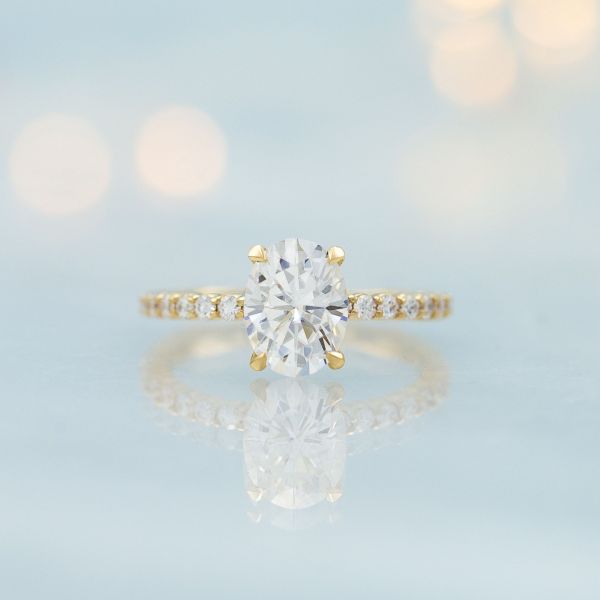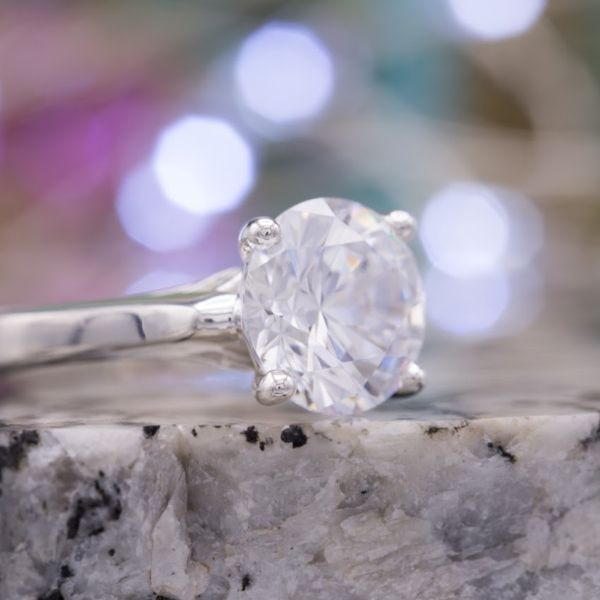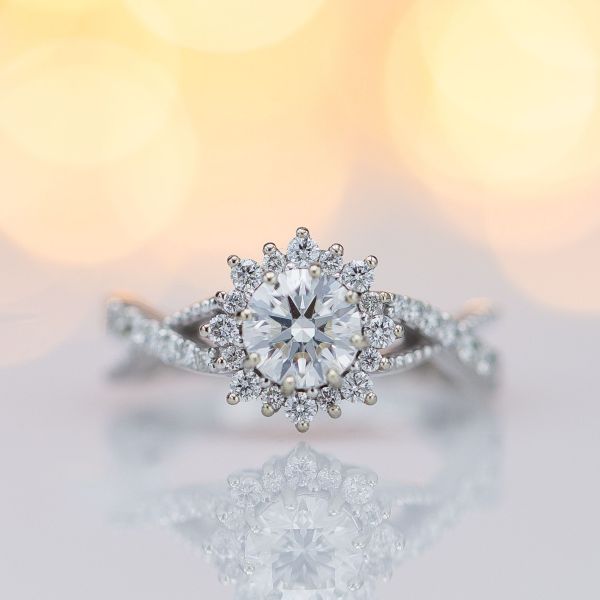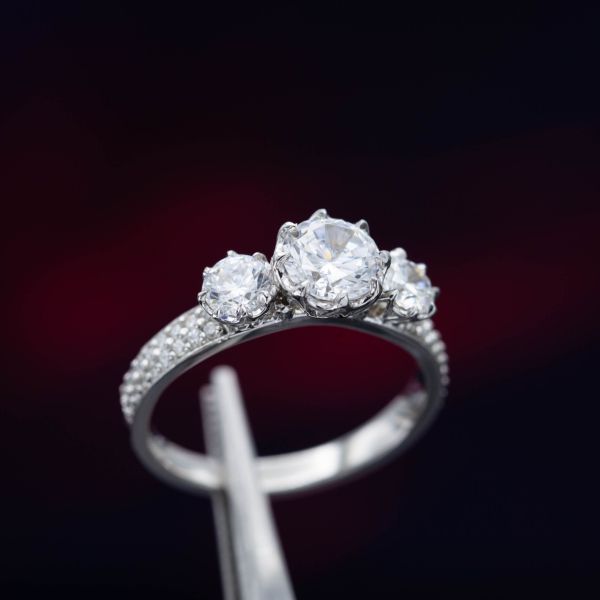Diamond Knowledge
Diamond Alternatives: Lab-Created, Moissanite, Cubic Zirconia, and more
What's out there beyond natural diamonds? Could it be right for you?
What can you choose besides a diamond?
Diamonds are far and away the most popular choice for engagement ring center stones. There are a lot of reasons for that, including some incredibly effective marketing campaigns. But if you're here for diamond conspiracy theories, you've come to the wrong place. We love diamonds! They're incredibly durable and sparkle like crazy. So, if diamonds are great, why look at alternatives? Well, first of all, there's this:
There's so much variety captured in those 5 rings, from the style to the gold color, the gem shape to the center stone choice. In fact, the looks are so different, you're likely to immediately find elements you love and some things that really aren't for you. So, when you look at these rings, do you find your eyes lingering on the gemstones, or are you just waiting for the diamonds to rotate back into view? If you're intrigued by the look of a colored gemstone, we'd encourage you to explore options like ruby, sapphire, emerald, morganite, and many other gems for your center stone.
But that's not what this article is about. In this piece, we'll compare diamonds to some of their colorless alternatives, like moissanite and cubic zirconia. We'll explain some of what gives diamonds their allure and help you understand how the alternatives compare.
The decision process
Colorless gemstones differ across a range of dimensions, but you can simplify your choice by asking yourself five key questions about your center stone:
- Does it need to be a diamond?
- Do I prefer a natural or lab-created gem?
- Do I love the stone’s visual beauty?
- Is the stone durable enough for lifelong daily wear?
- How does price impact my decision?
The answer to each question will depend on your personal situation and preferences. There are good reasons to choose any of the gems we'll discuss below. We’ll go into detail on each option, but here’s a summary of the case for each:
- Natural mined diamond: The quintessential choice for an engagement ring. Beauty, durability, luxury. If you have the budget for it, you can't go wrong with a natural diamond.
- Lab-created diamond: If you're set on a diamond but aren't quite as traditional and want more size for your money, lab-created can be a great option.
- Moissanite: An exceptional balance of quality and value. It doesn't have the name recognition of a diamond, but if you're open to non-diamond options, many argue that it's actually more visually beautiful.
- Cubic Zirconia (CZ): Pretty and cheap, cubic zirconia is a viable option for an extra tight budget, though we don't generally recommend it for heirloom rings due to inferior light performance and poor durability.
Next, let’s dive into some more detail on each question.
1. Is it a diamond? Does it need to be?
Lots of people laugh when they see this, but we think it’s the #1 most important question. Is your significant other counting on a diamond? Everyone knows that diamonds symbolize love, commitment, luxury, and quality. They’ve commanded a coveted place in mainstream culture for generations — scoring lyrical mentions by artists from Marilyn Monroe to The Beatles to Rihanna. Moissanite and cubic zirconia can be great alternatives, but you need to know going in that there’s no song called “Moissanites are a girl’s best friend.” If your significant other is open to a diamond alternative, it’s definitely worth exploring. If not, stick to diamond!
2. Natural vs. Lab-Created Origin
Diamonds form deep under the earth’s crust under intense heat and pressure. Natural diamonds sold today formed over a billion years ago and were then transported near the earth’s surface via volcanic kimberlite pipes. Today they are mined from the earth, primarily in Africa, Australia, Canada, and Russia. How’s that for an origin story? Hard to think of anything else you might buy that dates back a billion years and got to you by way of a volcano!
Lab diamonds are created by expensive, state-of-the-art machinery instead of in natural conditions in the earth. Both natural and lab-created diamonds end up having the same chemical structure — the colorless, crystalline form of pure carbon. Simulating the natural conditions of diamond creation is complicated and energy-intensive, which makes it costly — though not as costly or energy-intensive as mining. It was only in the past decade that gem quality 1ct+ lab-created diamonds started becoming readily available.
The case for natural diamonds:
- There’s a compelling romance to the long history of a mined diamond and its multi-billion year journey to your ring.
- The supply of mined diamonds is mature and relatively stable, which will help keep pricing stable and protect the resale value of natural stones. Improvements in lab-growing technology have the potential to drive up supply and drop lab-created prices, reducing the resale value.
- Natural diamonds are the most common and widely accepted choice for an engagement ring center stone.
The case for lab-created diamonds:
- You can buy a 100% genuine diamond at an over 80% discount. The analogy that makes the most sense to us is ice. Ice frozen outside and ice frozen in your freezer are both ice. One is natural and the other is manmade, but both are chemically identical.
- Lab-creation uses less energy and has less environmental impact than mining.
- Lab origin gives you peace of mind regarding fair wages and working conditions.
Moissanite and cubic zirconia are also lab-created, with processes specific to their chemical composition. Since natural versions aren’t available, we don’t discuss those tradeoffs here. But the labor and environmental implications of a lab-made gem apply just as well to these stones as to man-made diamonds.
It's extremely important to us that we only sell conflict-free diamonds. We only source stones that comply with the Kimberley Process, which was established in 2003 to prevent diamond purchases from financing civil wars in Africa and across the globe. More on ethical sourcing.
3. Visual Beauty
Diamonds are romantic, valuable, and durable — but none of that would matter if they weren't so darn beautiful. A diamond's beauty comes in large part from its signature sparkle. A clear piece of glass cut to the exact dimensions of a diamond doesn't shine nearly as much. Why is that? Diamond has an exceptional ability to bend light, which gemologists refer to as a high refractive index. This ability to bend light allows a well-cut diamond to take in light from all different angles and redirect it back toward your eye as sparkle.
A measure of how quickly light moves through a gemstone (e.g. diamond) relative to the air. The higher the refractive index, the more light will bend when it enters the gem and the more it can be reflected by the cut of the stone.
At 2.42, Diamond has a higher refractive index than almost any other gemstone, which is one of the reasons it is so special. There aren't any naturally occurring colorless gems that are good substitutes. Natural options like white sapphire, white topaz, and white zircon have lower refractive indices, making them appear more glasslike and less bright than diamonds. If you like the look of diamonds, we don't recommend any natural mined alternatives.
There are lab-created alternatives that can be a good fit for some customers. Cubic Zirconia gets close to a diamond’s light return at a refractive index of 2.17. Moissanite is the only option that can bend and return as much light as a diamond. In fact, moissanite’s 2.65 refractive index is higher than diamond’s, which gives it a bit of extra sparkle.
- In addition to a higher refractive index, moissanite also has a higher dispersion value, meaning that it separates more white light into colored light (like a prism) than diamond. That means moissanite produces more flashes of colored light called fire. To make moissanite's pattern of light return look more like that of a diamond, stones are typically cut to proportions that reduce their fire.
- Moissanite-lovers argue that extra brilliance and fire make moissanite more beautiful than diamond. Diamond-lovers counter that you can have too much fire and brilliance and that moissanite goes too far at the expense of things like contrast. This comes down to opinion and, frankly, we love both!
- Generally we think the more light return the better, especially because after a few weeks without cleaning, all stones will dull, so you want the most sparkle possible to keep shining through. This is especially true with fancy shapes, where light return has to be sacrificed for shape. Moissanite allows you to have your cake and eat it too, getting a fancy shape with the light return of a round.
4. Durability
Gemologists break down durability into three core characteristics — hardness, toughness, and stability.
Hardness — resistance to scratches
Hardness is the most well-known characteristic and is represented by the Mohs hardness scale. The higher a gem is on the scale, the harder it is. At 10 on the scale, diamond is the hardest known mineral and is extremely resistant to scratches. At 9.25, moissanite is also quite hard and scratch resistant. Cubic Zirconia comes in at an above average and reasonably hard 8.5.
Toughness — resistance to breaks or chips
All common colorless gemstones are at some risk of breaking or chipping. That’s why we assess chip risk by looking carefully at the thin corners of princess cut diamonds. Diamond and moissanite both have excellent toughness, with Cubic Zirconia also being relatively good — but with all gemstones, you should be careful to avoid impact.
There’s an old gemologist saying that illustrates how toughness differs from hardness: If you hit a diamond with a hammer, it'll shatter into a dozen pieces. If you hit a piece of quartz with a hammer, it'll split in two. If you hit a piece of jade with a hammer, it'll ring like a bell!
Stability — resistance to chemicals, oils, heat, humidity, and light
Stability is an area where moissanite and diamond meaningfully outshine cubic zirconia. As with hardness, both perform very well and will retain their heirloom quality under all standard conditions. By contrast, cubic zirconia is porous, meaning that it can absorb dirt, oils, and chemicals. These permanently dull the stone as they seep in over time. To maintain its quality, CZ requires similar care to occasional wear stones like Emerald and Opal.
Some companies have created branded CZ products that include coatings on top of the CZ. Initially, these coatings help with durability, as they protect CZ’s natural porosity. No coating is permanent, however, and damage to a coated portion makes any scratch or wear particularly noticeable.
5. Price
Price varies meaningfully between the different stone options. To give you a general sense, below is the rough cost, including the work of our bench jeweler to set it in your ring, of a 6.5mm round center stone of each type. For those more familiar with carat weight, that’s roughly equivalent to a 1ct diamond.
- Natural diamond: $4,300-8,000
- Lab-created diamond: $600-1,400
- Moissanite: $500-600
- Cubic zirconia: $60-70
Breakdown of each stone
We love colorless natural gems like white sapphire, white zircon, and white topaz. We don’t cover them in depth here because they have a distinctly different, less sparkly look than diamonds.
Addressing a number of gem myths
Let's do a bit of myth-busting! Here are just a few of the misconceptions we've heard about diamonds and diamond alternatives.
Myth: DeBeers controls the diamond market
At one point, De Beers did control the majority of diamond supply and managed global diamond prices by restricting supply. But that's no longer the case. De Beers abandoned its attempts to control pricing by the early 2000s and today other suppliers control 60-70% of the mining market.
Myth: Diamonds are a rip-off
Diamonds are certainly expensive, but that's because they are valuable. People all over the world want diamonds for their jewelry and there are only so many to go around. For CustomMade and many other jewelers, diamonds are among the least profitable items we sell. That’s because the diamond market is so competitive!
Myth: Lab-created diamonds are fake
Lab-created diamonds are not "fake." They have the same chemical structure as mined diamonds. That means they’ll have the same durability, sparkle, and beauty. Just not the same history.
Myth: Moissanite always has a yellow tinge
When it was first introduced into the market, most moissanite carried a yellow tinge. Today, innovations in the growing process have yielded a new crystal structure, meaning that there are plenty of colorless options available which can be graded on color just like diamonds. Objections that moissanite is "yellow" are based on an outdated understanding of what is available. We sell Charles & Colvard’s Forever One moissanite, which is graded colorless (D-E-F) on the diamond color scale.
Myth: Zircon and Cubic Zirconia are the same
Cubic Zirconia should not be confused with Zircon, a natural gemstone available in a range of colors, but most popular in blue. In fact, white zircon is an interesting diamond alternative in its own right! It has a lower refractive index so, like other natural alternatives, it’s not going to have the sparkle or brilliance of a diamond. But it exhibits a very cool property called birefringence (double refraction), which gives it a very distinctive shimmering appearance, almost as if it’s slightly out of focus.
Myth: Branded gems are diamonds
"Asha diamonds", "Nexus diamonds", and other branded diamond simulants are not diamonds. Despite confusing terminology, both are versions of CZ created in a lab with additional treatments or coatings applied. Candidly, we find the use of “diamond” to describe something that is not a diamond to be deliberately misleading. They should not be confused with lab-created diamonds, which are chemically identical to mined diamonds.
Myth: Amora Gem is a new type of stone
Amora Gem is the newer 4H crystal structure of moissanite. This is the same crystal used in Forever One moissanite, allowing both stones to be created in colorless D-E-F grades. Similar to Asha and Nexus, Amora presents deliberately confusing information in an attempt to differentiate their brand from the underlying chemical composition of the stone.
Myth: Diamond, Moissanite, and Cubic Zirconia have the same cut proportions
As we discussed in the Visual Beauty section, gems interact with light differently based on the refractive indices. Since Diamond bends light differently than moissanite, the optimal cut to reflect light back to your eye will be different. That means each gem type is cut to different proportions on purpose. Moissanite and CZ material typically have excellent cuts because the material is less costly to produce, meaning suppliers aren’t worried about sacrificing weight for cut quality.
Final thoughts
Hopefully this article has given you the tools to understand diamond alternatives logically, but getting engaged is about more than just logic. When you propose, you're taking a leap of faith. You deserve a ring that's personally meaningful and symbolizes lifelong commitment. We encourage you to learn the facts, but don't be afraid to trust your emotions.
About CustomMade
CustomMade designs and creates one-of-a-kind, custom engagement rings and fine jewelry. Each piece we create is inspired by you, designed for you, and made just for you.

